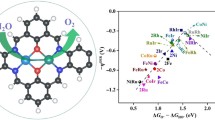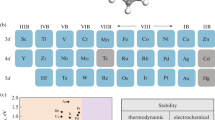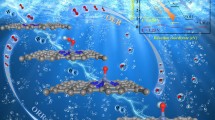Abstract
Modulating the coordination environments of single-atom catalysts (SAC) holds great potential to improve their catalytic activity in electrocatalysis. In this work, by means of comprehensive density functional theory computations, we systematically explored the catalytic performance of single Ir atom with different coordination environments for oxygen reduction reaction (ORR) and oxygen evolution reaction (OER). Our results showed that the introduction of nitrogen atoms can improve the catalytic activity of IrC4 for ORR and OER. Especially, IrN4 can be used as ORR and OER bifunctional electrocatalysts with the overpotentials (ηORR = 0.36 V and ηOER = 0.55 V). Interestingly, some descriptors, including energy descriptor (ΔGOH*), structure descriptor (φ), and d-band center (εd), can well explain the high catalytic activity of IrN4 towards ORR/OER. Our findings not only provide new insights into the development of efficient ORR and OER bifunctional electrocatalysts, but also open a new door to boost the catalytic performance of SACs.
Graphical Abstract
IrN4 was identified as efficient bifunctional catalyst for ORR and OER by exploring different N coordination environments through comprehensive density functional theory calculations, which is attributed to the ideal φ value and the d-band center near the Fermi energy level.








Similar content being viewed by others
References
Seh ZW, Kibsgaard J, Dickens CF, Chorkendorff I, Nørskov JK, Jaramillo TF (2017) Combining theory and experiment in electrocatalysis: insights into materials design. Science 355:4998
Chu S, Majumdar A (2012) Opportunities and challenges for a sustainable energy future. Nature 488:294–303
Ramakrishnan S, Velusamy DB, Sengodan S, Nagaraju G, Kim DH, Kim AR, Yoo DJ (2022) Rational design of multifunctional electrocatalyst: an approach towards efficient overall water splitting and rechargeable flexible solid-state zinc–air battery. Appl Catal B 300:120752
Rachna Devi H, Bisen OY, Cao X, Chen Z, Nanda KK (2022) Design of hierarchical oxide-carbon nanostructures for trifunctional electrocatalytic applications. Adv Mater Interfaces 9:2200071
Jiao D, Wang Z, Liu Y, Cai Q, Zhao J, Cabrera CR, Chen Z (2022) Mo2P monolayer as a superior electrocatalyst for urea synthesis from nitrogen and carbon dioxide fixation: a computational study. Energy Environ Mater. https://doi.org/10.1002/eem2.12496
He Y, Yang X, Li Y, Liu L, Guo S, Shu C, Liu F, Liu Y, Tan Q, Wu G (2022) Atomically dispersed Fe–Co dual metal sites as bifunctional oxygen electrocatalysts for rechargeable and flexible Zn–air batteries. ACS Catal 12:1216–1227
Wang R, Liu B, You S, Li Y, Zhang Y, Wang D, Tang B, Sun Y, Zou J (2022) Three-dimensional Ni3Se4 flowers integrated with ultrathin carbon layer with strong electronic interactions for boosting oxygen reduction/evolution reactions. Chem Eng J 430:132720
Chen J-W, Zhang Z, Yan H-M, Xia G-J, Cao H, Wang Y-G (2022) Pseudo-adsorption and long-range redox coupling during oxygen reduction reaction on single atom electrocatalyst. Nat Commun 13:1734
Zhang Z, Li J, Qian J, Li Z, Jia L, Gao D, Xue D (2022) Significant change of metal cations in geometric sites by magnetic-field annealing FeCo2O4 for enhanced oxygen catalytic activity. Small 18:2104248
Lin R, Cai X, Zeng H, Yu Z (2018) Stability of high-performance Pt-based catalysts for oxygen reduction reactions. Adv Mater 30:1705332
Nie Y, Li L, Wei Z (2015) Recent advancements in Pt and Pt-free catalysts for oxygen reduction reaction. Chem Soc Rev 44:2168–2201
Osgood H, Devaguptapu SV, Xu H, Cho J, Wu G (2016) Transition metal (Fe Co, Ni, and Mn) oxides for oxygen reduction and evolution bifunctional catalysts in alkaline media. Nano Today 11:601–625
Lee Y, Suntivich J, May KJ, Perry EE, Shao-Horn Y (2012) Synthesis and activities of rutile IrO2 and RuO2 nanoparticles for oxygen evolution in acid and alkaline solutions. J Phys Chem Lett 3:399–404
Gong Q, Wang Y, Hu Q, Zhou J, Feng R, Duchesne PN, Zhang P, Chen F, Han N, Li Y, Jin C, Li Y, Lee S-T (2016) Ultrasmall and phase-pure W2C nanoparticles for efficient electrocatalytic and photoelectrochemical hydrogen evolution. Nat Commun 7:13216
Lim J, Jung J-W, Kim N-Y, Lee GY, Lee HJ, Lee Y, Choi DS, Yoon KR, Kim Y-H, Kim I-D, Kim SO (2020) N2-dopant of graphene with electrochemically switchable bifunctional ORR/OER catalysis for Zn-air battery. Energy Storage Mater 32:517–524
Singh H, Marley-Hines M, Chakravarty S, Nath M (2022) Multi-walled carbon nanotube supported manganese selenide as a highly active bifunctional OER and ORR electrocatalyst. J Mater Chem A 10:6772–6784
Wang Q, Feng Q, Lei Y, Tang S, Xu L, Xiong Y, Fang G, Wang Y, Yang P, Liu J, Liu W, Xiong X (2022) Quasi-solid-state Zn-air batteries with an atomically dispersed cobalt electrocatalyst and organohydrogel electrolyte. Nat Commun 13:3689
Bai X, Zhao X, Zhang Y, Ling C, Zhou Y, Wang J, Liu Y (2022) Dynamic stability of copper single-atom catalysts under working conditions. J Am Chem Soc 144:17140–17148
Fang X, Shang Q, Wang Y, Jiao L, Yao T, Li Y, Zhang Q, Luo Y, Jiang H-L (2018) Single Pt atoms confined into a metal–organic framework for efficient photocatalysis. Adv Mater 30:1705112
Guo X, Lin S, Gu J, Zhang S, Chen Z, Huang S (2019) Simultaneously achieving high activity and selectivity toward two-electron O2 electroreduction: the power of single-atom catalysts. ACS Catal 9:11042–11054
Han N, Wang Y, Ma L, Wen J, Li J, Zheng H, Nie K, Wang X, Zhao F, Li Y, Fan J, Zhong J, Wu T, Miller DJ, Lu J, Lee S-T, Li Y (2017) Supported cobalt polyphthalocyanine for high-performance electrocatalytic CO2 reduction. Chem 3:652–664
Jiao D, Liu Y, Cai Q, Zhao J (2021) Coordination tunes the activity and selectivity of the nitrogen reduction reaction on single-atom iron catalysts: a computational study. J Mater Chem A 9:1240–1251
Kong L, Chen Z, Cai Q, Yin L, Zhao J (2022) Efficient electrochemical reduction of CO to C2 products on the transition metal and boron Co-doped black phosphorene. Chin Chem Lett 33:2183–2187
Wan X, Liu Q, Liu J, Liu S, Liu X, Zheng L, Shang J, Yu R, Shui J (2022) Iron atom–cluster interactions increase activity and improve durability in Fe–N–C fuel cells. Nat Commun 13:2963
Wang Z, Yu Z, Zhao J (2018) Computational screening of a single transition metal atom supported on the C2N monolayer for electrochemical ammonia synthesis. Phys Chem Chem Phys 20:12835–12844
Wang Z, Zhao J, Wang J, Cabrera CR, Chen Z (2018) A Co–N4 moiety embedded into graphene as an efficient single-atom-catalyst for NO electrochemical reduction: a computational study. J Mater Chem A 6:7547–7556
Zhao J, Chen Z (2017) Single Mo atom supported on defective boron nitride monolayer as an efficient electrocatalyst for nitrogen fixation: a computational study. J Am Chem Soc 139:12480–12487
Jiao D, Zhang D, Wang D, Fan J, Ma X, Zhao J, Zheng W, Cui X (2023) Applying machine-learning screening of single transition metal atoms anchored on N-doped γ-graphyne for carbon monoxide electroreduction toward C1 products. Nano Res. https://doi.org/10.1007/s12274-023-5773-0
Wang H, Wang Q, Cheng Y, Li K, Yao Y, Zhang Q, Dong C, Wang P, Schwingenschlögl U, Yang W, Zhang XX (2012) Doping monolayer graphene with single atom substitutions. Nano Lett 12:141–144
Zhang L, Jia Y, Gao G, Yan X, Chen N, Chen J, Soo MT, Wood B, Yang D, Du A, Yao X (2018) Graphene defects trap atomic Ni species for hydrogen and oxygen evolution reactions. Chem 4:285–297
Zhao P, Peng C, Zhang Q, Fan X, Chen H, Zhu Y, Min Y (2023) Carbon-coordinated atomic cobalt directly embedded on carbon cloth for alkaline hydrogen evolution at high current density. Chem Eng J 461:142037
Gao G, Bottle S, Du A (2018) Understanding the activity and selectivity of single atom catalysts for hydrogen and oxygen evolution via ab initial study. Catal Sci Technol 8:996–1001
Sun T, Zang W, Yan H, Li J, Zhang Z, Bu Y, Chen W, Wang J, Lu J, Su C (2021) Engineering the coordination environment of single cobalt atoms for efficient oxygen reduction and hydrogen evolution reactions. ACS Catal 11:4498–4509
Tong M, Wang L, Fu H (2021) Designed synthesis and catalytic mechanisms of non-precious metal single-atom catalysts for oxygen reduction reaction. Small Methods 5:2100865
Zhu Y, Sokolowski J, Song X, He Y, Mei Y, Wu G (2020) Engineering local coordination environments of atomically dispersed and heteroatom-coordinated single metal site electrocatalysts for clean energy-conversion. Adv Energy Mater 10:1902844
Kresse G, Hafner J (1993) Ab initio molecular dynamics for liquid metals. Phys Rev B 47:558–561
Blöchl PE (1994) Projector augmented-wave method. Phys Rev B 50:17953–17979
Kresse G, Joubert D (1999) From ultrasoft pseudopotentials to the projector augmented-wave method. Phys Rev B 59:1758–1775
Perdew JP, Burke K, Ernzerhof M (1996) Generalized gradient approximation made simple. Phys Rev Lett 77:3865–3868
Grimme S (2006) Semiempirical GGA-type density functional constructed with a long-range dispersion correction. J Comput Chem 27:1787–1799
Martyna GJ, Klein ML, Tuckerman M (1992) Nosé–Hoover chains: the canonical ensemble via continuous dynamics. J Chem Phys 97:2635–2643
Kelly SR, Kirk C, Chan K, Nørskov JK (2020) Electric field effects in oxygen reduction kinetics: rationalizing pH dependence at the Pt(111), Au(111), and Au(100) electrodes. J Phys Chem C 124:14581–14591
Lu Z, Chen G, Siahrostami S, Chen Z, Liu K, Xie J, Liao L, Wu T, Lin D, Liu Y, Jaramillo TF, Nørskov JK, Cui Y (2018) High-efficiency oxygen reduction to hydrogen peroxide catalysed by oxidized carbon materials. Nat Catal 1:156–162
Man IC, Su H-Y, Calle-Vallejo F, Hansen HA, Martínez JI, Inoglu NG, Kitchin J, Jaramillo TF, Nørskov JK, Rossmeisl J (2011) Universality in oxygen evolution electrocatalysis on oxide surfaces. ChemCatChem 3:1159–1165
Cerrón-Calle GA, Senftle TP, Garcia-Segura S (2022) Strategic tailored design of electrocatalysts for environmental remediation based on density functional theory (DFT) and microkinetic modeling. Curr Opin Electrochem 35:101062
Kour G, Mao X, Du A (2022) Computational screening of single-atom alloys TM@Ru(0001) for enhanced electrochemical nitrogen reduction reaction. J Mater Chem A 10:6204–6215
Liu H, Zhang Z, Li M, Wang Z, Zhang X, Li T, Li Y, Tian S, Kuang Y, Sun X (2022) Iridium doped pyrochlore ruthenates for efficient and durable electrocatalytic oxygen evolution in acidic media. Small 18:2202513
Song L, Zhang X, Zhu S, Xu Y, Wang Y (2022) Transition metal (Fe, Ni, and Zn) doping-induced modulation of geometric and electronic structures to optimize the potential-determining step of MnCo2O4 for oxygen evolution reaction. Sci China Mater 65:2871–2878
Wang J, Li K, Hao Q, Liu D, Zhang X (2023) Electroreduction NO to NH3 over single metal atom anchored on pyrrole type defective graphene: a DFT study. Chin Chem Lett 34:107567
Wen G, Liang J, Liu Q, Li T, An X, Zhang F, Alshehri AA, Alzahrani KA, Luo Y, Kong Q, Sun X (2022) Ambient ammonia production via electrocatalytic nitrite reduction catalyzed by a CoP nanoarray. Nano Res 15:972–977
Wu J, Yang L, Liu X, Xiao B, Ao Z (2023) Transition metal decorated bismuthene for ammonia synthesis: a density functional theory study. Chin Chem Lett 34:107659
Yang C, Wu Y, Wang Y, Zhang H-N, Zhu L-H, Wang X-C (2022) Electronic properties of double-atom catalysts for electrocatalytic oxygen evolution reaction in alkaline solution: a DFT study. Nanoscale 14:187–195
Zhong Y, Zhao X-J, Feng Y-L, Lu H, Yin P, Chen Z-R, Jie Y, Guo J-Y, Pu M, Yan H (2022) DFT study on the electrochemical synthesis of ammonia over Mo2C(121) with N-doping. Mol Catal 530:112637
Nørskov JK, Rossmeisl J, Logadottir A, Lindqvist L, Kitchin JR, Bligaard T, Jónsson H (2004) Origin of the overpotential for oxygen reduction at a fuel-cell cathode. J Phys Chem B 108:17886–17892
Rossmeisl J, Qu ZW, Zhu H, Kroes GJ, Nørskov JK (2007) Electrolysis of water on oxide surfaces. J Electroanal Chem 607:83–89
Li X, Liu L, Ren X, Gao J, Huang Y, Liu B (2020) Microenvironment modulation of single-atom catalysts and their roles in electrochemical energy conversion. Sci Adv 6:6833
Wang Q, Huang X, Zhao ZL, Wang M, Xiang B, Li J, Feng Z, Xu H, Gu M (2020) Ultrahigh-loading of Ir single atoms on NiO matrix to dramatically enhance oxygen evolution reaction. J Am Chem Soc 142:7425–7433
Wang Q, Zhang Z, Cai C, Wang M, Zhao ZL, Li M, Huang X, Han S, Zhou H, Feng Z, Li L, Li J, Xu H, Francisco JS, Gu M (2021) Single iridium atom doped Ni2P catalyst for optimal oxygen evolution. J Am Chem Soc 143:13605–13615
Mathew K, Sundararaman R, Letchworth-Weaver K, Arias TA, Hennig RG (2014) Implicit solvation model for density-functional study of nanocrystal surfaces and reaction pathways. J Chem Phys 140:084106
Kwak D, Khetan A, Noh S, Pitsch H, Han B (2014) First principles study of morphology, doping level, and water solvation effects on the catalytic mechanism of nitrogen-doped graphene in the oxygen reduction reaction. ChemCatChem 6:2662–2670
Zhang Q, Asthagiri A (2019) Solvation effects on DFT predictions of ORR activity on metal surfaces. Catal Today 323:35–43
Hai X, Zhao X, Guo N, Yao C, Chen C, Liu W, Du Y, Yan H, Li J, Chen Z, Li X, Li Z, Xu H, Lyu P, Zhang J, Lin M, Su C, Pennycook S, Zhang C, Xi S, Lu J (2020) Engineering local and global structures of single Co atoms for a superior oxygen reduction reaction. ACS Catal 10:5862–5870
Sun T, Mitchell S, Li J, Lyu P, Wu X, Pérez-Ramírez J, Lu J (2021) Design of local atomic environments in single-atom electrocatalysts for renewable energy conversions. Adv Mater 33:2003075
He T, Matta SK, Will G, Du A (2019) Transition-metal single atoms anchored on graphdiyne as high-efficiency electrocatalysts for water splitting and oxygen reduction. Small Methods 3:1800419
Cheng Y, Dai J, Song Y, Zhang Y (2019) Nanostructure of Cr2Co2 MXene supported single metal atom as an efficient bifunctional electrocatalyst for overall water splitting. ACS Appl Energy Mater 2:6851–6859
Xu H, Cheng D, Cao D, Zeng XC (2018) A universal principle for a rational design of single-atom electrocatalysts. Nat Catal 1:339–348
Acknowledgements
This work was financially supported by the Harbin Normal University Science and Technology Innovation Climbing Program Funding Project (XKB202212).
Author information
Authors and Affiliations
Corresponding author
Ethics declarations
Conflict of Interest
We have no conflicts of interest to declare.
Additional information
Publisher's Note
Springer Nature remains neutral with regard to jurisdictional claims in published maps and institutional affiliations.
Supplementary Information
Below is the link to the electronic supplementary material.
Rights and permissions
Springer Nature or its licensor (e.g. a society or other partner) holds exclusive rights to this article under a publishing agreement with the author(s) or other rightsholder(s); author self-archiving of the accepted manuscript version of this article is solely governed by the terms of such publishing agreement and applicable law.
About this article
Cite this article
Zhu, Y., Wang, Z. Tuning the N Coordination Environment of Ir Single-Atom-Catalyst for Highly Efficient ORR and OER: A Computational Study. Catal Lett 154, 2464–2474 (2024). https://doi.org/10.1007/s10562-023-04490-0
Received:
Accepted:
Published:
Issue Date:
DOI: https://doi.org/10.1007/s10562-023-04490-0




